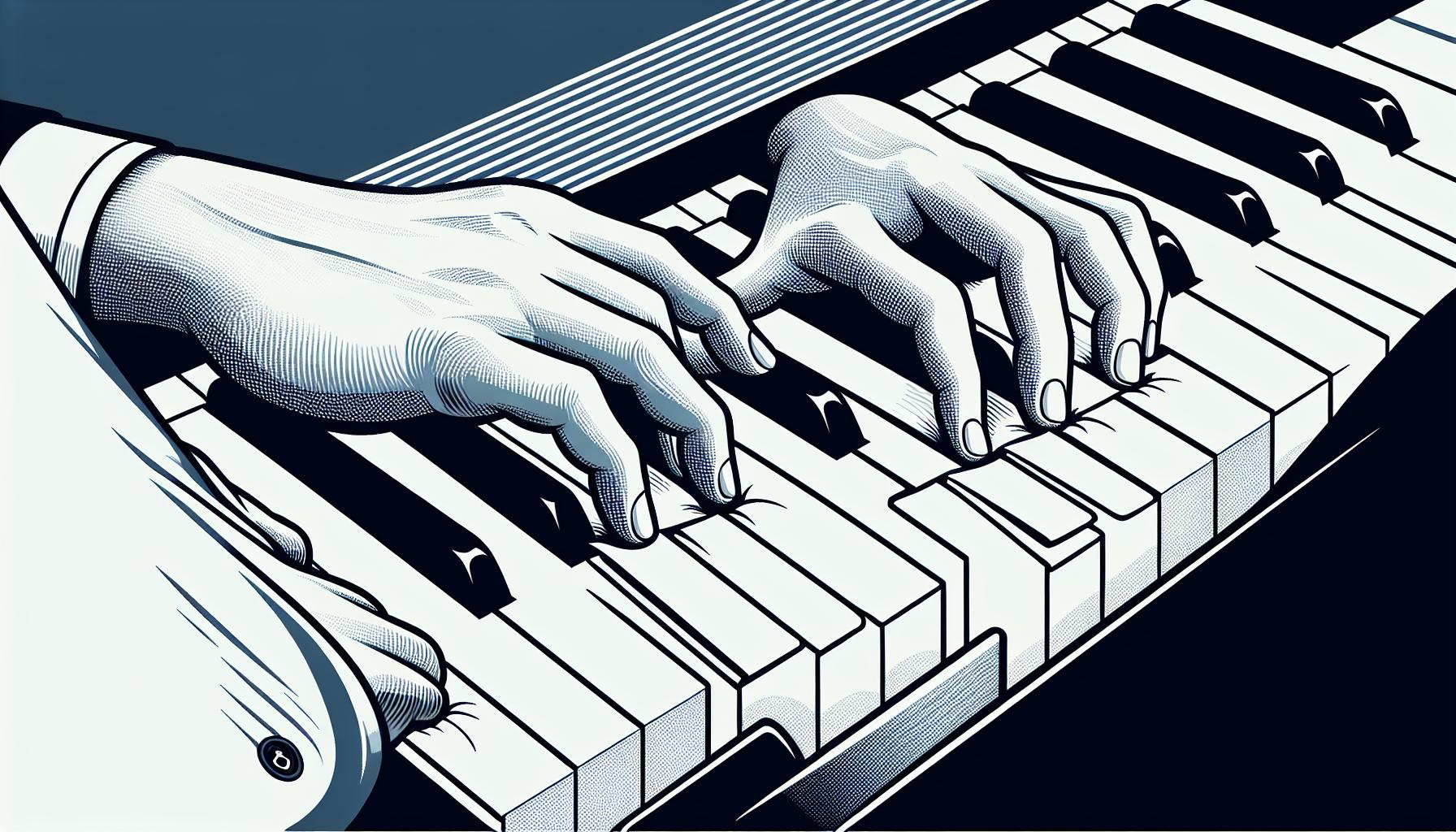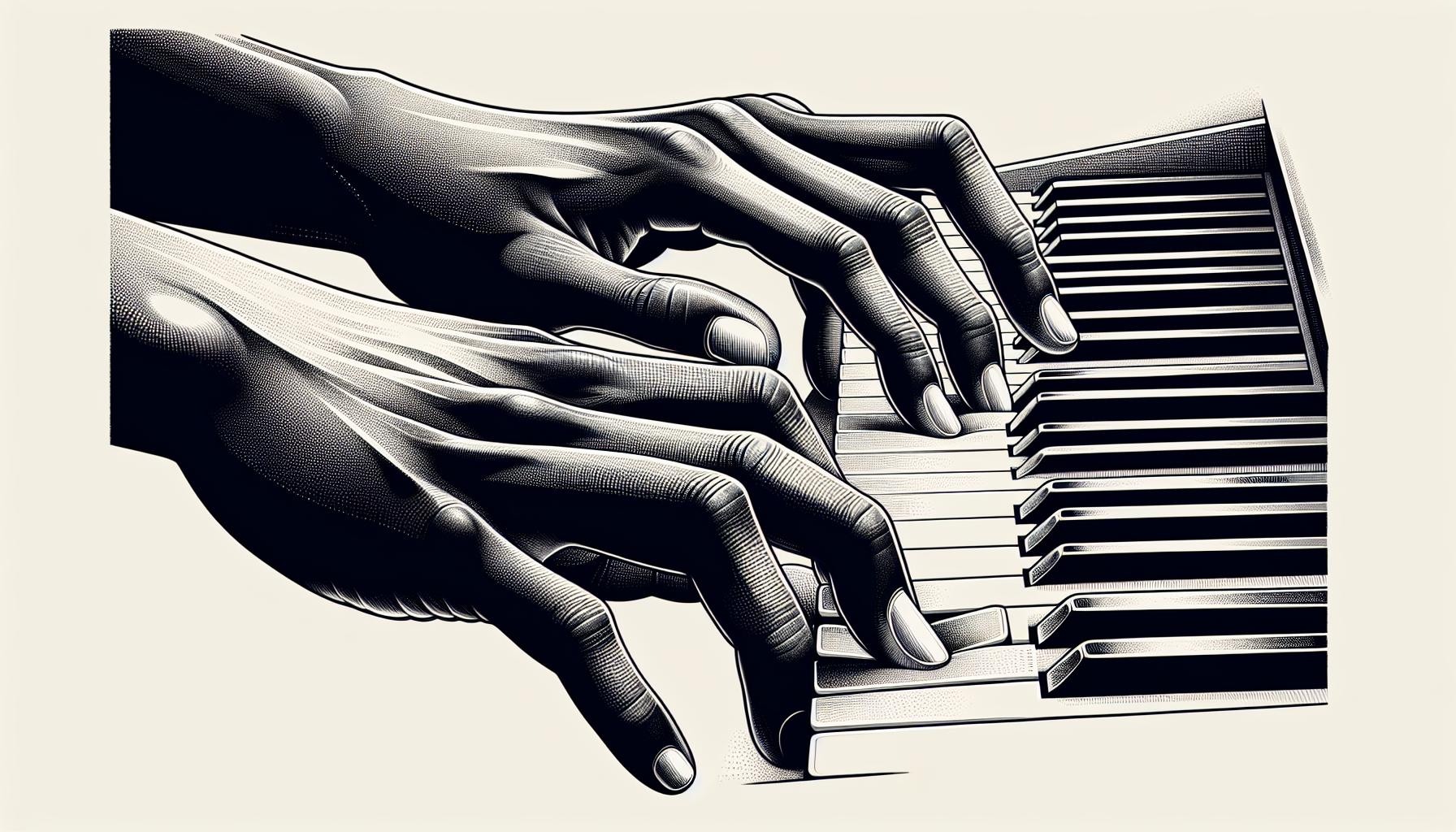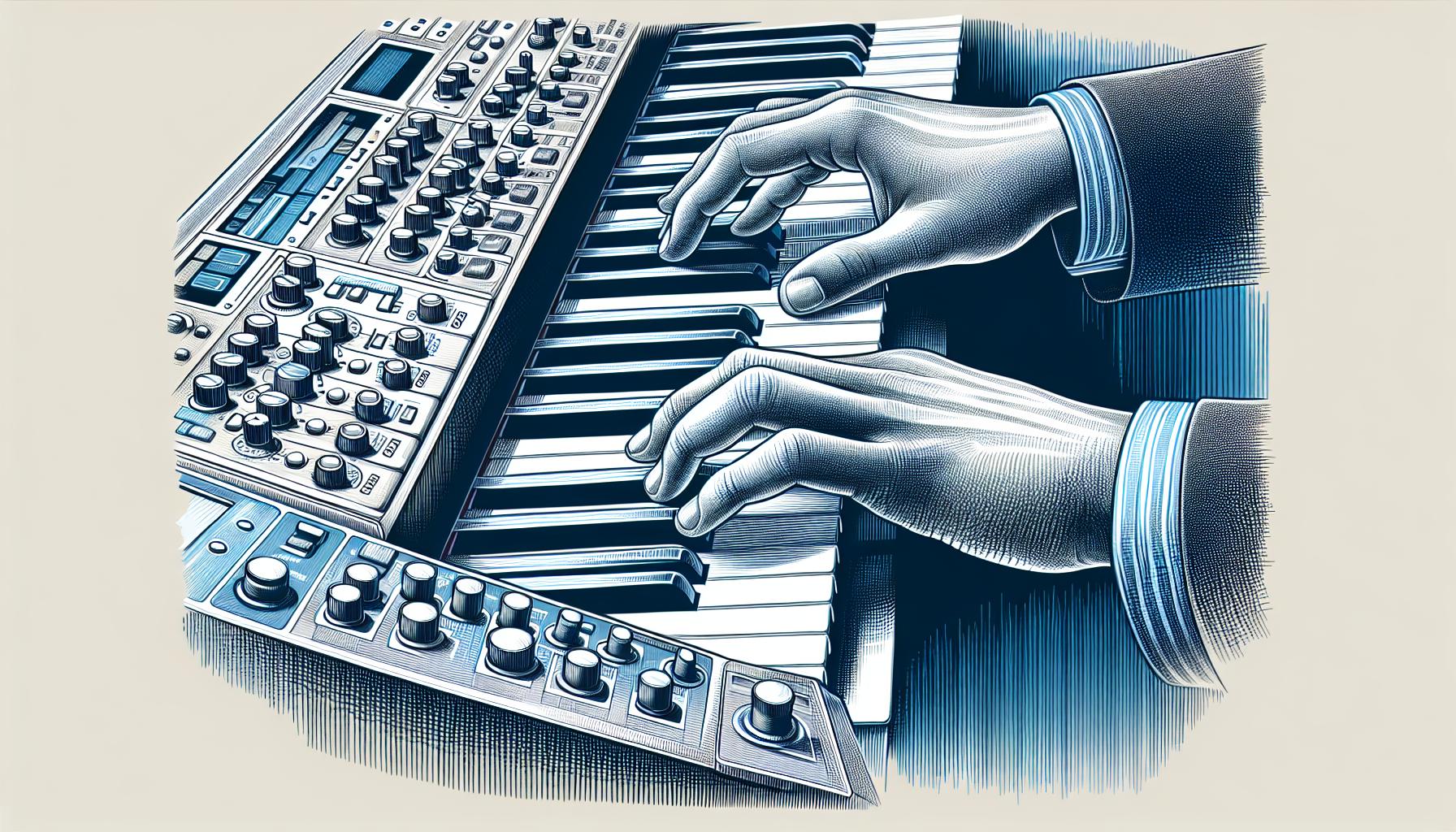Diving into the world of blues music can be a thrilling adventure, especially when you're doing it from the comfort of your keyboard. The blues scale, with its soulful bends and heartfelt expressions, is a cornerstone of this genre's unmistakable sound. It's not just a scale; it's a doorway into an expressive world where every note tells a story.
For many, the thought of playing blues scales on a keyboard seems daunting, but it's actually more accessible than one might think. Whether you're a seasoned pianist looking to explore new genres or a complete novice eager to start your musical journey, mastering the blues scale can add a rich layer of emotion to your playing. Let's embark on this musical journey together, discovering the magic of blues scales and how they can transform your keyboard playing.
Understanding the Blues Scale
The essence of blues music comes alive through its signature scale. The blues scale, a pentatonic scale with an added flattened fifth, is pivotal in creating that soul-stirring and foot-tapping rhythm synonymous with blues music. This scale, unlike others, carries a unique blend of notes that evoke a wide range of emotions, from melancholy to joy.
For those venturing into the world of keyboard blues, understanding the structure of the blues scale is the first step toward mastery. The scale essentially consists of six notes: the root, flat third, fourth, flat fifth, fifth, and flat seventh. This combination is what gives the blues scale its characteristic sound, differentiating it from the standard major and minor scales primarily used in Western music.
Let's break down the scale in the key of C, as it's one of the easiest scales to learn for beginners:
| Note | C | Eb | F | Gb | G | Bb |
|---|---|---|---|---|---|---|
| Interval | 1 | b3 | 4 | b5 | 5 | b7 |
Practicing the scale in C is a great starting point because it allows learners to get comfortable with the intervals without worrying about sharp or flat notes, other than those within the scale itself. Once the scale is comfortably mastered in C, branching out to other keys becomes significantly easier.
To truly get the feel of the blues, it's essential not only to play the scale up and down but to experiment with it. The beauty of blues lies in its expressiveness and the personal touch one can add. Playing with dynamics, bending notes, and experimenting with rhythms are all ways to bring the blues scale to life on the keyboard. These techniques allow musicians to convey the depth of emotion that blues music embodies.
One common approach to learning the blues scale on the keyboard is to start with the right hand, focusing on getting the notes under the fingers. Once comfortable, the left hand can then be introduced, starting with simple bass lines or chords that complement the scale. This method facilitates an understanding of how the blues scale interacts with other elements of music, providing a foundation for improvisation and composition.
Mapping Out the Blues Scale on the Keyboard

Once a beginner gets acquainted with the essence of the blues scale and its emotional depth, the next step is mapping it out on the keyboard, a process that's vital for both understanding and performance. The keyboard, with its visually linear layout, serves as the perfect instrument for beginners to easily grasp the structure of the blues scale.
The blues scale, especially in the key of C, offers a tangible starting point for novices. This scale consists of the notes C, Eb, F, F#, G, and Bb. Visually, on a keyboard, this selection combines both white and black keys, providing a straightforward pattern that can be memorized and executed even by someone just starting their musical journey.
When embarking on this learning path, it's advisable to start with the right hand. The thumb (finger 1) should be positioned on C, the index finger (finger 2) on Eb, the middle finger (finger 3) on F, the ring finger (finger 4) on F#, and the little finger (finger 5) on G. This fingering pattern helps in creating a fluid motion through the scale, and with practice, it becomes second nature. The Bb is easily reached by extending the little finger or by shifting the hand position slightly, ensuring the entire scale is accessible without discomfort.
For the left hand, the fingering mirrors the right but in reverse order, encouraging ambidextrous skill development which is crucial for more advanced pieces where the hands play distinct, interweaving parts. Initially, focusing on mastering the scale with the right hand before moving to the left hand simplifies the learning process. However, integrating both hands early on is beneficial for developing coordination and a deeper understanding of the scale’s structure in relation to keyboard harmony and melody.
An effective way to practice is by using a metronome, starting at a slow tempo to ensure accuracy in finger placement and timing. Gradually increasing the speed as proficiency develops not only enhances agility but also instills a sense of rhythm and groove, essential components in blues music.
Furthermore, experimenting with different dynamics (playing loud vs. soft) and incorporating various rhythms (straight vs. swung feel) within the scale practice brings the blues to life on the keyboard. It's in these variations that players find their unique voice, making the blues a personal and expressive journey.
Practicing Techniques for Blues Scale Mastery

Once musicians have mapped the blues scale on the keyboard and grasped the fingering for both hands, the next step is to dive into practicing techniques that pave the way for mastery. It's essential to approach this phase with patience and persistence as these skills contribute to a musician's ability to inject soul and emotion into their performance.
One effective method for mastering the blues scale is slow, focused practice. Start by playing the scale slowly, ensuring each note sounds clean and precise. This method not only reinforces muscle memory but also allows musicians to listen closely to the tones and intervals of the blues scale, deepening their understanding of its structure.
Incorporating repetition is crucial for solidifying knowledge of the blues scale. Musicians should practice the scale in various keys, not just the key of C, to become versatile in their playing. Shifting between keys helps build agility and adaptability on the keyboard. Here’s a simple plan musicians can follow to add variety to their practice sessions:
- Day 1: Practice the blues scale in C and G.
- Day 2: Practice in D and A.
- Day 3: Practice in E and B.
This sequence encourages comprehensive familiarity with the keyboard layout across different scales, promoting a rounded skill set.
Another technique to consider is the use of backing tracks. Playing along with blues backing tracks can significantly enhance one’s timing and rhythm. It simulates a real-life jamming session, offering an immersive experience that challenges musicians to keep up with the pace while staying in key. This practice is both enjoyable and highly educational, as it trains the ear and improves improvisational skills.
Call and response exercises are also highly beneficial. They involve listening to a musical phrase and then responding to it with an improvisation or repetition of the phrase. This technique hones a musician's listening skills, improvisation, and ability to interact musically, which is paramount in blues music.
Finally, incorporating dynamics and articulation into the practice of the blues scale cannot be overstated. Playing with variations in volume and attack brings expressiveness to the music, making the notes sing. Techniques such as bends, slides, and vibrato add a vocal quality to keyboard playing, further enhancing the bluesy feel.
Incorporating Blues Scales into Your Playing

Once keyboard players have a grasp of the blues scale, the next step is to seamlessly incorporate it into their playing. This isn't just about playing the scale up and down. It's about making the scale work in the context of music, breathing life into performances. One of the first strategies is playing over blues progressions. Taking a simple 12-bar blues progression and adding in blues scale runs, licks, and motifs can elevate the overall feel and introduce players to the foundational structure of blues music.
Improvisation plays a significant role in blues music, and the blues scale is a powerful tool for improvisation. Players should start with slow, simple improvisation exercises, focusing on a few notes at a time. They can gradually expand to more complex improvisations as they become more comfortable. It's important to listen to a lot of blues music to understand how experienced musicians use the scale effectively in their improvisations.
Another effective method for incorporating the blues scale into keyboard playing is through call and response exercises. This age-old practice, traditionally used in blues and gospel music, involves playing a phrase (call) and responding to it with another phrase (response) using the blues scale. This not only helps in developing musical ideas but also in improving listening and improvisation skills.
To further enhance the ability to incorporate the blues scale, keyboard players should practice in different rhythm and timing contexts. Experimenting with swing rhythms, shuffle beats, and straight eighth or sixteenth notes can add variety and authenticity to blues scale applications. It’s also beneficial to play along with recordings from different blues artists to grasp the diverse ways the blues scale can be articulated and expressed.
- Use Backing Tracks: Playing along with blues backing tracks can provide a solid rhythmic and harmonic foundation, making it easier to experiment with the blues scale.
- Transpose the Scale: Learning to play the blues scale in all twelve keys increases versatility and deepens the understanding of the keyboard layout.
- Incorporate Dynamics: Adding dynamics and articulation marks, like crescendos, decrescendos, and accents, can make the use of the blues scale more expressive.
- Limitation Exercises: Limiting improvisation to certain notes of the blues scale or certain fingers can push creativity and skill development.
Advancing Your Blues Scale Skills

Once keyboard players have a firm grasp on the basics of playing blues scales, it's time to elevate their music. Advancing blues scale skills involves not just repeating patterns, but also integrating them into more complex musical contexts. Here are several strategies that can help musicians deepen their understanding and utilization of blues scales on the keyboard.
Incorporating Blues Scales into Different Genres
Blues scales aren't confined to blues music; they can add a soulful touch to a variety of genres. By blending blues scales into jazz, rock, and even pop, players can create unexpected and fresh sounds. Experimentation is key. Trying blues scales over different chord progressions and in songs outside the traditional blues genre can broaden a musician's creative horizon.
- Experiment with genres: Jazz, Rock, Pop
- Try different chord progressions
Mastering Techniques for Expressiveness
To truly capture the essence of blues, keyboard players must master techniques that add expressiveness to their playing. Techniques such as bends (simulated by pitch wheels on electronic keyboards), vibrato, and slurs can mimic the vocal-like qualities that are so prominent in blues music. Emphasizing the blue note within the scale can also add a distinctive, soulful quality that resonates with listeners.
- Use pitch wheels for bends
- Practice vibrato and slurs
- Emphasize the blue note
Playing with Others
One of the most effective ways to advance blues scale skills is by playing with other musicians. Jamming with a band or even a duo can expose keyboard players to new ideas and ways of thinking about blues scales. This experience can be invaluable for learning how to adapt and respond musically in real-time.
- Join jam sessions
- Collaborate with musicians
Improvisation and Solos
Improvisation is at the heart of blues music. Keyboard players should allocate time to focus solely on improvisation, using blues scales as their foundation. This can be structured as dedicated improv sessions or as part of regular practice. Creating solos over blues progressions not only builds technical proficiency but also enhances a musician's ability to express emotions and tell a story through their music.
- Dedicate time to improvisation
- Create solos over blues progressions
Conclusion
Mastering the blues scale on the keyboard opens up a world of musical expression and creativity. By diving into different genres, adopting essential techniques, and engaging with other musicians, players can truly capture the soulful essence of blues music. The journey doesn't stop at learning the scales; it's about making them your own through improvisation and emotional storytelling. So, grab your keyboard, find your groove, and let the blues take you where words cannot. Remember, practice, patience, and passion are your best friends on this musical adventure. Happy playing!
Harlan Kilstein began playing piano during covid with no piano background at all. He taught himself how to play learning what to do and what not to do.
Today he's an advanced intermediate player and can help you grow in your skills because he learned all this on his own.






